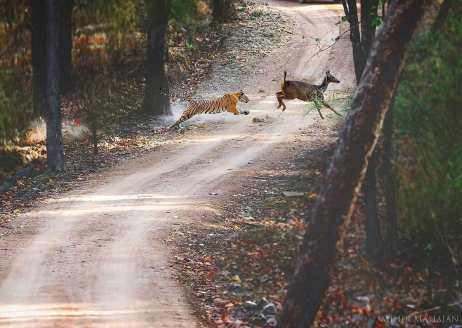
Kingdom: Animalia
Phylum: Chordata
Class: Mammalia
Order: Carnivora
Suborder: Feliformia
Family: Felidae
Subfamily: Pantherinae
Genus: Panthera
Species: P. tigris
Subspecies: P. t. tigris
“The tiger is the largest member of the felid (cat) family. They sport long, thick reddish coats with white bellies and white and black tails. Their heads, bodies, tails and limbs have narrow black, brown or gray stripes. There were once nine subspecies of tigers: Bengal, Siberian, Indochinese, South Chinese, Sumatran, Malayan, Caspian, Javan and Bali. Of these, the last three are extinct, one is extinct in the wild, and the rest are endangered”
The Bengal tiger, also known as the Royal Bengal Tiger or the Indian tiger, is the subspecies with the largest population. It is the national animal of India, place where its image is part of the traditions and the culture. In Bangladesh, it is also the national animal present even in the bills.
There were eight tiger subspecies at one time, but three became extinct during the 20th century. Over the last 100 years, hunting and forest destruction have reduced tiger populations from hundreds of thousands of animals to perhaps fewer than 2,500. Tigers are hunted as trophies, and also for body parts that are used in traditional Chinese medicine. All five remaining tiger subspecies are at-risk, and many protection programs are in place.
Bengal tigers live in India and are sometimes called Indian tigers. They are the most common tiger and number about half of all wild tigers. Over many centuries they have become an important part of Indian tradition and lore.
BEHAVIOR

Tigers live alone and aggressively scent-mark large territories to keep their rivals away. They are powerful nocturnal hunters that travel many miles to find buffalo, deer, wild pigs, and other large mammals. Tigers use their distinctive coats as camouflage (no two have exactly the same stripes). They lie in wait and creep close enough to attack their victims with a quick spring and a fatal pounce. A hungry tiger can eat as much as 60 pounds in one night, though they usually eat less.
Despite their fearsome reputation, most tigers avoid humans; however, a few do become dangerous maneaters. These animals are often sick and unable to hunt normally, or live in an area where their traditional prey has vanished.
Females give birth to litters of two to six cubs, which they raise with little or no help from the male. Cubs cannot hunt until they are 18 months old and remain with their mothers for two to three years, when they disperse to find their own territory.
PHYSICAL DESCRIPTION

The morphology of the Bengal tiger is beautiful and imposing. It is a mammal with thick legs, strong teeth and jaws and coat with the characteristic coloration pattern. In this regard, its skin shows a yellow to light orange color that in the belly and the internal areas of the legs becomes white or cream. Black, gray or brown stripes run vertically down all its body before the tail, where they become rings. There is a rare variant of the Bengal tiger. Due to a genetic mutation, some specimens exhibit a white coat with dark stripes and blue eyes, but it is important to know that they are not albino tigers, just a genetic variety.
The coat of these felines is useful for camouflage but differs from individual to individual. In fact, there are not two Bengal tigers with the dark stripes arranged in the same way, but they make up a uniquely identifiable pattern such as fingerprints in humans.
Males are typically larger and heavier than females. While the former have a length of 106-122 inches including the tail, the latter measure from 94 to 104 inches in length. Only the tail is between 33 and 43 inches long. The weight of males can range between 400 to 550 pounds, while that of females is 220-353 lbs.
DISTRIBUTION AND HABITAT

The largest populations of Bengal tigers are in India, but there are some smaller groups in Bangladesh, Nepal, and Bhutan. It may also be present in areas of China and Burma. An estimate of the World Tiger Recovery Program indicates that there are about 440 individuals in Bangladesh, about 155 in Nepal and about 75 in Bhutan. The approximate number of specimens is less than 2,500.
However, the latest census of 2016 indicates that there are 106 tigers in Bangladesh, 103 in Buthan, 198 in Nepal and 2,226 in India. This information is from government sources and is not confirmed by independent organizations.
Bengal tiger habitats usually are tropical rainforests, marshes, and tall grasses.

FEEDING
The power of the Bengal tiger is evident when observing its effectiveness at the time of hunting. This carnivorous animal search for medium or large prey, mainly ungulate mammals. In their diet, predominates the gaur, water buffalo, sambar, chital or mottled deer, wild boar and other species of deer. They occasionally consume small prey such as rabbits and porcupines, and may also attack domestic livestock; This is a consequence of the invasion of their habitat. Bengal tigers can ingest up to 40 kilograms of food on a single occasion, although they usually consume a smaller amount.

Since they can not follow prey for long distances, they use a strategy that combines stealth and camouflage. In the sunlight, the tiger hides in the tall grass to stalk an animal. Camouflage can be so effective that the unsuspecting prey can be just a few meters away from the tiger. When it is ready, it attacks silently by the side or behind the victim, jumps quickly and strikes with a blow with its retractable claws or a bite in the neck. Then drag the animal several meters to consume it or can even transport the body through to the water.
REPRODUCTION
As mentioned, the Bengal tigers are individuals who perform most of their activities alone, except, of course, breeding. In this sense, the only social interactions occur during courtship, copulation, and parental care.
The basic social unit is that of the mother with her cubs. There is no mating season, but most of the offspring are born in the months of December to April. The sexual maturity in males occurs between 4 and five years of age, being earlier in females as they mature between 3 and four years.
The gestation period is on average 104-106 days, although they may be as less as 98 days, or a little more, up to 110 days. The female gives birth to 1 to 4 puppies in a place between the vegetation or in caves or crevices and begins to breastfeed them during 3-6 months after birth. At an age between 5 and six months, they start learning how to hunt, and at the age of 2 or 3 years, they begin their solitary life.
THREATS AND CONSERVATION

The Bengal tiger is in danger of extinction, according to the International Union for Conservation of Nature (IUCN). Although it is the most populated species, its numbers keep decreasing rather than increasing, which has worried environmental organizations.
The main threats to this species are two: poaching and conflicts with humans over the territories. Poaching aim is to illegally trade the products obtained from tigers, such as decorative objects or the active ingredient of “drugs” to cure various diseases, but which have no proven efficacy. Their habitat, severely degraded by logging, and the invasion of humans in their territories keeps reducing. When tigers attack domestic animals or even humans, they unleash the wrath of people who in retaliation kill them.
Fortunately, since the 1970s India began to establish reserves through the Tiger Project that helped stabilize the Number of tigers. Also, the Indian Wildlife Protection Act of 1972 empowers the government to take conservation measures.
What is also interesting is that there is about 1% which are DNA verified hybrids. They have one parent that is a Bengal Tiger and one that is a Siberian Tiger. These hybrid tigers seem to do quite well in the wild with most of the males being sterile. Some think that this genetic link though was the result of mistakes in breeding while in captivity and then released into the wild.
The Wildlife Protection Society of India continues watching all allegations of tiger poaching. They have confiscated large amounts of tiger parts and pelts, but it is often hard for them to get to the source of who is responsible for killing and shipping them. Even though they arrest those caught with them, there are more people involved in the process than they can catch.
To get away with poaching though many of these hunters have shifted to poisoning the Tigers. Then they are found already dead, and they can’t be held responsible for killing them which is also the same practice that many farmers do to protect their livestock.
Witten By,
Rtr. Sethil Muhandiram
President 18-19






Leave a comment